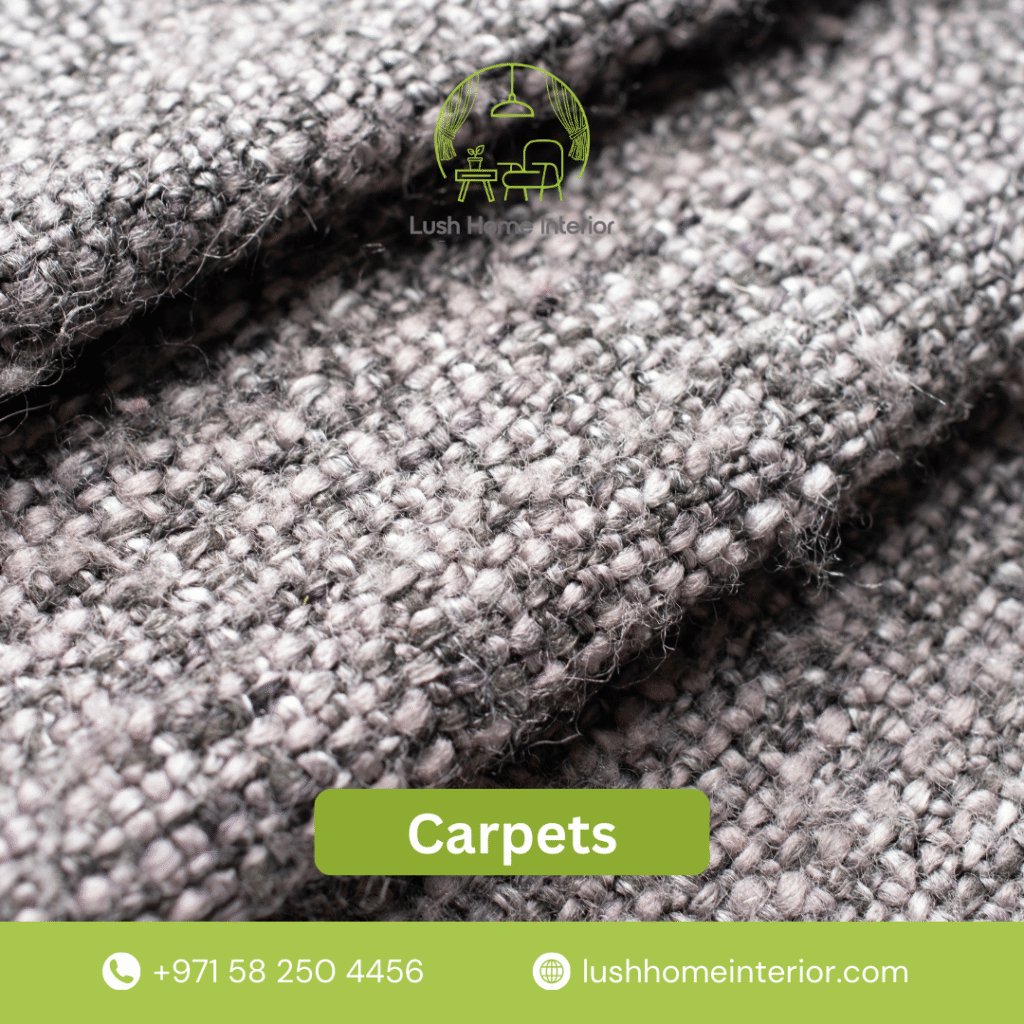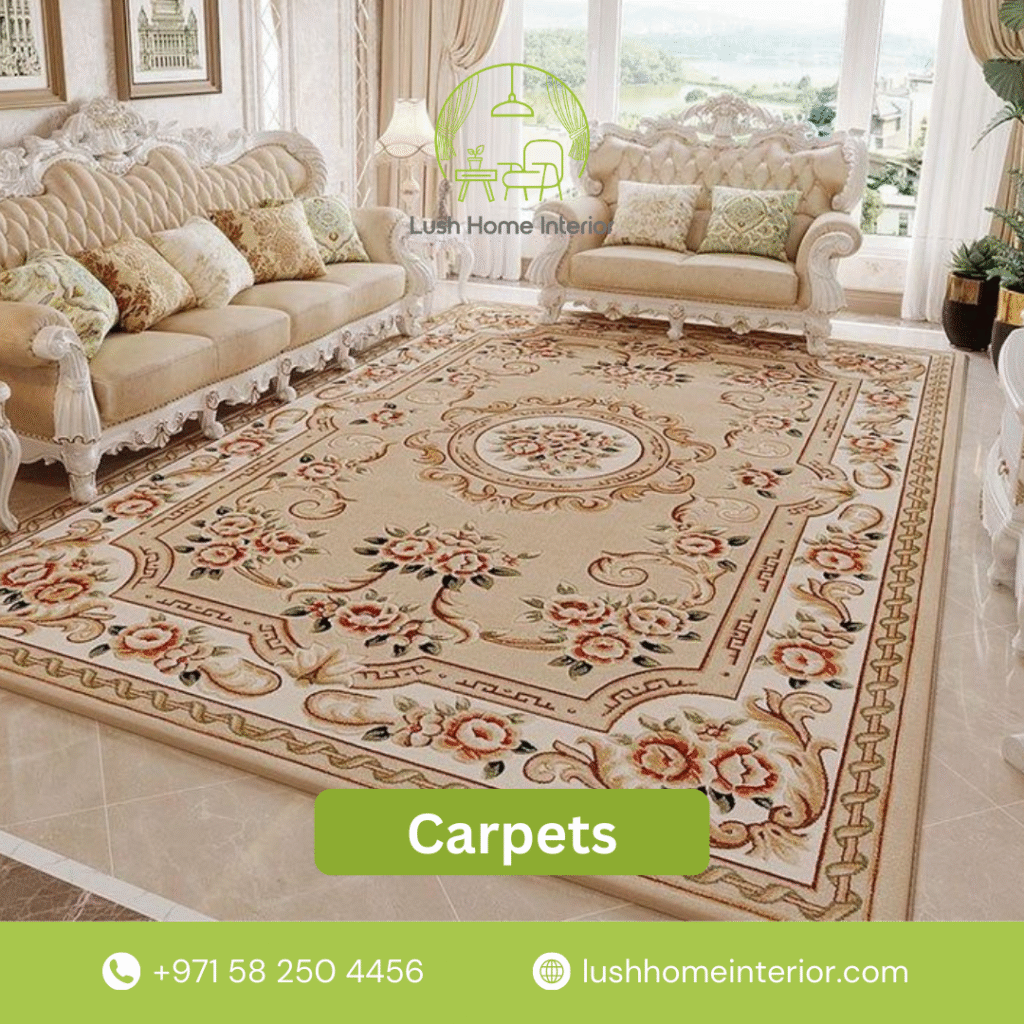Menu
Looking to add warmth, comfort, and style to your home? Consider installing high-quality carpets! In this article, we’ll explore the benefits of carpets, including comfort, insulation, aesthetic appeal, and noise reduction. We’ll also cover the different types of carpets available and provide tips for choosing a reputable provider. With the right installation, you’ll be able to enjoy the benefits of carpets for years to come.
Carpets are a type of floor covering made from woven fabric, typically consisting of an upper layer of pile attached to a backing. The pile is usually made from materials such as wool, nylon, polyester, or polypropylene and comes in a variety of styles, textures, and colors. Carpets are used to enhance the comfort and aesthetic appeal of a space, providing a soft and warm surface underfoot.












Use our online estimator to select your curtains’ style, size, color, requirements and our professional team will contact you personally for pricing.
Add multiple products to cart and submit at once for a quote.
Our Consultant will take measurements and help you choose your style and fabrics for Free.
Use our in-build compare feature to select the best suitable option for yourself.
Review your quotation, pay in 4 monthly installments through Tabby or Tamara or completely upfront.
We offer a 1 year guarantee on curtains and roller blinds, and 5 years on motors
Offering virtual tours or showcasing their showroom through content like videos or interactive presentations can give customers a glimpse of their offerings, attracting them to visit or make online purchases.
Carpets work by providing a cushioned layer between your feet and the floor. This layer of fabric traps heat, providing insulation and helping to maintain a comfortable temperature in your home. Additionally, carpets absorb sound, reducing noise levels and creating a quieter living environment. They also add a decorative element to any room, enhancing the overall design and feel of the space.
Are you tired of cold, hard floors that lack character and comfort? If so, it may be time to consider installing carpets. Not only do they add a touch of warmth and coziness to your home, but they can also provide insulation, noise reduction, and aesthetic appeal. In this article, we’ll explore everything you need to know about carpets, from the different types available to the benefits they offer. By the end, you’ll be ready to upgrade your home with this versatile and stylish flooring option.
Carpets are made from a variety of materials, each offering different benefits and characteristics. Here are some of the most common materials used in carpets:
When choosing carpets, it’s important to consider the material’s durability, maintenance requirements, and how it fits with your lifestyle and aesthetic preferences.
Carpets come with a variety of features that make them a popular choice for homeowners looking for comfort and style. Here are some of the top features of carpets:
Overall, the features of carpets are designed to enhance the comfort, style, and functionality of your home. By choosing the right carpet for your needs, you can enjoy a more comfortable and inviting living space.
There are several types of carpets available on the market today, each with its own unique features and benefits. Here are some of the most popular types of carpets:
Each type of carpet has its own advantages and disadvantages, so it’s important to choose the one that best suits your needs and preferences. With the wide range of options available, you’re sure to find the perfect carpet to enhance your home’s comfort and style.
Comfort: Carpets provide a soft and cushioned surface underfoot, making your home more comfortable and inviting.
Insulation: Carpets help to insulate your home, keeping it warm in the winter and cool in the summer. They can also help reduce energy costs.
Noise Reduction: Carpets absorb sound, reducing noise levels and creating a quieter living environment.
Aesthetic Appeal: With a wide range of colors, patterns, and textures available, carpets can enhance the aesthetic appeal of any room.
Safety: Carpets provide a non-slip surface, reducing the risk of accidents and injuries.
Durability: High-quality carpets are built to last, maintaining their appearance and comfort for many years with proper care and maintenance.
Allergen Control: Carpets can trap dust and allergens, improving indoor air quality when regularly cleaned.
Overall, the benefits of carpets make them a worthwhile investment for homeowners looking to improve their comfort, style, and energy efficiency. By choosing the right carpet with the features that meet your needs and preferences, you can enjoy a more comfortable and inviting living space for years to come.
Measure the Room: Measure the width and length of your room to determine the amount of carpet you need. Make sure to add a few extra inches to ensure full coverage and allow for trimming.
Choose the Carpet Type: Choose the type of carpet that best suits your needs and preferences, such as cut pile, loop pile, or patterned carpets.
Prepare the Subfloor: Ensure that the subfloor is clean, dry, and level. Remove any old flooring and repair any damage to the subfloor.
Install Carpet Padding: Lay down carpet padding to provide extra cushioning and insulation. Secure the padding with staples or adhesive.
Cut and Lay the Carpet: Cut the carpet to the appropriate size, allowing for some excess. Lay the carpet over the padding, making sure it is centered and aligned.
Trim and Secure the Carpet: Trim the excess carpet along the edges of the room. Use a knee kicker and carpet stretcher to ensure a tight fit. Secure the carpet with tack strips or adhesive.
Finish the Edges: Finish the edges of the carpet by tucking it into the baseboards or installing transition strips.
If you’re not comfortable with DIY installation, you can also hire a professional to install your carpet for you. Just make sure to choose a reputable installer who has experience with your specific type of carpet. With proper installation, your carpet can enhance your home’s comfort, style, and insulation for years to come.
In conclusion, updating your home with quality furnishings can significantly enhance your living space’s comfort, style, and functionality. With a variety of materials, types, and features to choose from, you’re sure to find the perfect pieces to suit your needs and preferences.
When investing in furnishings, be sure to do your research and choose reputable brands and suppliers. Look for furniture that offers the features and durability you need to enjoy a beautiful and functional home for years to come.
We offer a variety of carpets, including cut pile, loop pile, cut and loop, patterned, and textured carpets. Each type has unique features and benefits to suit different needs and preferences.
When choosing a carpet, consider factors such as the room’s usage, foot traffic, and your lifestyle. For high-traffic areas, opt for durable and stain-resistant materials. For bedrooms, consider softer and more luxurious options.
To measure your room, calculate the width and length, and add a few extra inches to ensure full coverage. This will help you determine the amount of carpet needed for your space.
While DIY installation is possible, hiring a professional is recommended for the best results. Professional installers have the expertise and tools needed to ensure a flawless installation.
Regular vacuuming is essential to keep your carpet clean. For spills and stains, blot the area with a clean cloth and use a carpet cleaner suitable for your carpet type. Professional cleaning is recommended periodically to maintain the carpet’s appearance and longevity.
The lifespan of a carpet depends on its material, quality, and maintenance. With proper care, high-quality carpets can last anywhere from 10 to 20 years.
FOR ORDER:
You can call the sales team for a no-obligation quotation on
+971 58 250 4456 or e-mail us on info@lushhomeinterior.com
